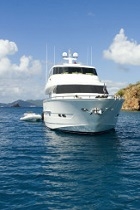Comsys Survey Sees No Letup In Maritime Market Growth

The maritime satellite broadband market continued its sharp upward march in 2014, surpassing 20,000 ships with installed terminals despite the headwind of lower crude-oil prices and generating about $1.3 billion in revenue, according to the annual industry survey by Comsys of London.
The installed base has nearly doubled since 2010 and shows no sign of a growth slowdown, according to Comsys. Once considered a luxury, broadband connectivity is now viewed as a must-have for ship fleets seeking to retain qualified personnel.
The Comsys results show that KVH Industries of Middletown, Rhode Island — a large customer for ViaSat Inc. terminal hardware — retained its place as the No. 1 provider of high-speed satellite services in 2014, with a market share of 17.9 percent, or more than 3,700 vessels.
Vessel count is not revenue. Comsys estimates that Airbus Defence and Space, in second place with a 9.6 percent share of the vessel market, surpassed KVH in maritime satellite services revenue given that it serves a higher-yield sector of the market.
London-based Inmarsat, whose L-band service remains the most-installed satellite system in the maritime market, was in third position in 2014, with 8 percent of the market for high-speed terminals, called VSATs, or Very Small Aperture Terminals. These operate mainly in Ku-band, with Ka-band entering the market with several satellites in orbit and scheduled for launch in the next year or two.
Harris CapRock (5 percent), NSSL Global (4 percent), SpeedCast (3.9 percent) and MTN Communications (3.3 percent) round out the list of major service providers in a market that continues to be highly fractured.

Credit: Comsys/SpaceNews
According to Comsys, 48.3 percent of the market is spread among dozens of service providers, many with fleets of no more than five or 10 ships.
“We have counted at least 172 operators in this market,” said Simon Bull, senior consultant for Comsys. “Lots of them have fleets of two ships, or three, or seven.”
It may be this aspect of the market — it seems ripe for consolidation — that several private-equity investors find appealing as they consider the acquisition of Airbus’ commercial VSAT business. As part of a corporate recentering on core markets, Airbus has put its commercial VSAT service business — but not the military and government business — up for sale.
Evert Dudok, head of Airbus’ Communications, Intelligence and Security (CIS) division, said March 16 during the Satellite 2015 conference and exhibition in Washington that the sale is expected to be concluded by midyear.
Dudok said the company signed up 600 new ships in 2014, double the number of 2013, which itself was double the installation rate in 2011.

Dudok was speaking of gross additions to the fleet, before accounting for customer churn, meaning ship fleets that switch providers. The company’s 2014 fleet installations totaled 2,017, up 363 from the previous year. He said the company has received many expressions of interest for its commercial mobile satellite services business.
Evert Dudok, head of Airbus’ Communications, Intelligence and Security (CIS) division. Credit: ESA.
But industry officials attending the Satellite 2015 conference said the sale has been delayed repeatedly since late 2014 and that Airbus had not yet issued a detailed document of the division’s performance to permit prospective buyers to perform due diligence reviews.
Inmarsat has expressed interest in the business, but given Inmarsat’s weight in the maritime satellite communications market, such a transaction may run into European anti-trust issues.
Inmarsat’s current VSAT business, developed through several acquisitions, is designed to pave the way for Inmarsat’s Global Xpress Ka-band system, expected to reach global coverage later this year with the launch of the third Global Xpress satellite.
Bull said that despite aggressive pricing, Inmarsat has not established a dominant position in the VSAT market notwithstanding its acquisition of other suppliers. Using 2014 data, a combined Inmarsat-Airbus maritime VSAT business would have had a 17.6 percent share of the installed maritime market — about equal that of KVH, but with substantially more revenue.
Inmarsat Chief Executive Rupert Pearce said March 18 at the Satellite 2015 conference that Inmarsat’s current business as a wholesaler will not change despite an increase in its direct-sales business in recent years.
Direct sales, Pearce said, account for just 20 percent of Inmarsat’s revenue. “I have no desire to increase that,” he said, a statement that would argue against a bid for the Airbus business.
In a March 24 interview, Bull said the maritime VSAT market is about to be shaken anew by the arrival of O3b Networks and its constellation of Ka-band broadband satellites using an unusual equatorial medium Earth orbit, and by the coming launch of high-throughput satellites — from Intelsat, Telesat and others — using Ku-band and aiming at the maritime and aeronautical markets.
Antennas are also advancing, featuring higher speeds, multifrequency dish antennas and even an all-plastic design that could remove the need for a radome and save valuable real estate on ships.
Comsys’ assessment of antenna sales is current only to the end of 2013. At that point, Intellian was the clear market leader, with 35.6 percent of the market, followed by SeaTel (21.8 percent), KVH (16.6 percent), KNS (9.6 percent) and Thrane (7.5 percent).
Cobham of Britain has purchased Thrane to add to SeaTel, and the combined fleet antenna installation in 2013 had 29.3 percent of the market, according to Comsys.

Post your comment
You cannot post comments until you have logged in.
Login to post a commentComments
No one has commented on this page yet.
RSS feed for comments on this page | RSS feed for all comments